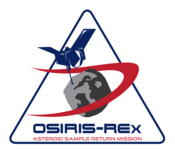OSIRIS-REx
OSIRIS-APEX ('APophis EXplorer') is an ongoing mission (as of 2024). It is the extension of OSIRIS-REx, that was a NASA asteroid-study and sample-return mission.[9] In 2023, the OSIRIS-REx mission was completed (or finished).
 Drawing of the OSIRIS-REx spacecraft | |||||||||||||||
| Names | OSIRIS-REx OSIRIS-APEX | ||||||||||||||
|---|---|---|---|---|---|---|---|---|---|---|---|---|---|---|---|
| Mission type | Asteroid sample return[1] and flyby of another asteroid | ||||||||||||||
| Operator | NASA / Lockheed Martin | ||||||||||||||
| COSPAR ID | 2016-055A | ||||||||||||||
| SATCAT no. | 41757 | ||||||||||||||
| Website | asteroidmission.org | ||||||||||||||
| Spacecraft properties | |||||||||||||||
| Manufacturer | Lockheed Martin | ||||||||||||||
| Launch mass | 2,110 kg (4,650 lb)[2] | ||||||||||||||
| Dry mass | 880 kg (1,940 lb)[2] | ||||||||||||||
| Dimensions | 2.44 × 2.44 × 3.15 m (8 ft 0 in × 8 ft 0 in × 10 ft 4 in)[2] | ||||||||||||||
| Power | 1226 to 3000 W[2] | ||||||||||||||
| Start of mission | |||||||||||||||
| Launch date | 8 September 2016, 23:05 UTC[3] | ||||||||||||||
| Rocket | Atlas V 411, AV-067[3] | ||||||||||||||
| Launch site | Cape Canaveral, SLC-41 | ||||||||||||||
| Contractor | United Launch Alliance | ||||||||||||||
| Orbital parameters | |||||||||||||||
| Reference system | Bennu-centric | ||||||||||||||
| Altitude | 0.68–2.1 km (0.42–1.30 mi)[4][5] | ||||||||||||||
| Period | 22–62 hours[6][5] | ||||||||||||||
| Flyby of Earth | |||||||||||||||
| Closest approach | 22 September 2017[2][7] | ||||||||||||||
| Distance | 17,237 km (10,711 mi)[7] | ||||||||||||||
| Bennu orbiter | |||||||||||||||
| Orbital insertion | 31 December 2018[8] (Rendezvous: 3 December 2018) | ||||||||||||||
| Orbital departure | 3 March 2021 (planned)[2] | ||||||||||||||
| Sample mass | c. 121 g (4.29 oz) | ||||||||||||||
| |||||||||||||||
 OSIRIS-REx mission logo | |||||||||||||||
Acronym: OSIRIS-REx stands for Origins, Spectral Interpretation, Resource Identification, Security, Regolith Explorer.
The mission from 2016 to 2023
changeThe OSIRIS-REx mission collected samples from 101955 Bennu, a carbonaceous near-Earth asteroid, and returned the samples to earth in September 2023.[10]
The material returned is expected to enable scientists to learn more about the formation and evolution of the Solar System, its initial stages of planet formation, and the source of organic compounds that led to the formation of life on Earth.[11]
The mission was completed, when the Sample Return Capsule was recovered.
Landing date: Sample Return Capsule: September 24, 2023
Landing site of capsule: Utah Test and Training Range
OSIRIS-REx is the first United States spacecraft to return samples from an asteroid.
OSIRIS-APEX
changeAfter dropping off its sample to Earth on 24 September 2023, the mission OSIRIS-REx became OSIRIS-APEX ('APophis EXplorer').
In 2029, the spacecraft is supposed to start observations of (Apophis or) 99942 Apophis.
Mission duration
changeCounting the years and months of the first and second missions: 8 years, 3 months (elapsed)
The first mission: 7 years (planned)
889 days at asteroid (actual)
References
change- ↑ Brown, Dwayne C. (25 May 2011). "NASA To Launch New Science Mission To Asteroid In 2016". NASA. Archived from the original on 29 April 2012. Retrieved 18 September 2016. This article incorporates text from this source, which is in the public domain.
- ↑ 2.0 2.1 2.2 2.3 2.4 2.5 "OSIRIS-REx: Asteroid Sample Return Mission" (PDF) (Press Kit). NASA. August 2016. Archived from the original (PDF) on 9 September 2016. Retrieved 18 September 2016. This article incorporates text from this source, which is in the public domain.
- ↑ 3.0 3.1 Graham, William (8 September 2016). "Atlas V begins OSIRIS-REx's round trip to the asteroid Bennu". NASASpaceflight. Retrieved 18 September 2016.
- ↑ "NASA's OSIRIS-REx Mission Breaks Another Orbit Record". asteroidmission.org. NASA. 13 June 2019. Retrieved 19 July 2020. This article incorporates text from this source, which is in the public domain.
- ↑ 5.0 5.1 "Mission Update February 25, 2019". asteroidmission.org. NASA. 25 February 2019. Retrieved 19 July 2020. This article incorporates text from this source, which is in the public domain.
- ↑ "Mission Update August 12, 2019". asteroidmission.org. NASA. 12 August 2019. Retrieved 19 July 2020. This article incorporates text from this source, which is in the public domain.
- ↑ 7.0 7.1 "NASA'S OSIRIS-REx Spacecraft Slingshots Past Earth". NASA. 2017-09-22. Retrieved 2018-04-26. This article incorporates text from this source, which is in the public domain.
- ↑ "NASA'S OSIRIS-REx Spacecraft Arrives at Asteroid Bennu". NASA. 3 December 2018. Retrieved 6 December 2018. This article incorporates text from this source, which is in the public domain.
- ↑
- Brown, Dwayne; Neal-Jones, Nancy (31 March 2015). "RELEASE 15-056 - NASA's OSIRIS-REx Mission Passes Critical Milestone". NASA. Retrieved 4 April 2015. This article incorporates text from this source, which is in the public domain.
- Chang, Kenneth (5 September 2016). "NASA Aims at an Asteroid Holding Clues to the Solar System's Roots". The New York Times. Retrieved 6 September 2016.
- Corum, Jonathan (8 September 2016). "NASA Launches the Osiris-Rex Spacecraft to Asteroid Bennu". The New York Times. Retrieved 9 September 2016.
- Chang, Kenneth (8 September 2016). "The Osiris-Rex Spacecraft Begins Chasing an Asteroid". The New York Times. Retrieved 9 September 2016.
- ↑ "NASA's First Asteroid Sample Has Landed, Now Secure in Clean Room - NASA". Retrieved 2023-10-25.
- ↑ "OSIRIS-REx Mission Selected for Concept Development". NASA. Archived from the original on 6 June 2012. This article incorporates text from this source, which is in the public domain.